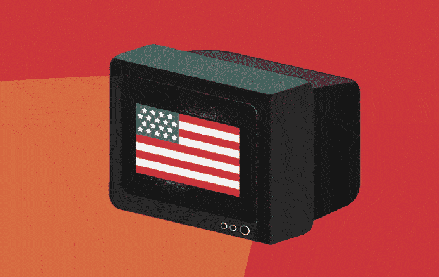As political ad spend faucet opens, CTV media stands to be a major winner

Political advertising spend has kicked into a higher gear in recent weeks in the U.S.
CTV is becoming an increasingly popular method of reaching swing voters, especially in the local and statewide elections that collectively account for the lion’s share of U.S. political ad spend, publishers, ad tech vendors and media buyers told Digiday.
Experts say that spend is expected to only increase as the Republican nominee, former President Donald Trump, and his Democrat counterpart — presumed to be Vice President Kamala Harris — face off in November.
2024 spend is up over the 2020 election cycle
According to MediaRadar data shared with Digiday, the dueling presidential campaigns and their respective allies had already spent $385 million as of Aug. 8 this year, and have scheduled a further $322 million in ad buys. The Democrats, thus far, are the bigger spenders.
More recently, in the second quarter of 2024, political ad spend was pegged as being almost 35% higher than in the same period during the 2020 election cycle, according to Operative STAQ, an ad management company. The firm’s spending data showed that ad spend from just one conservative political action committee, Americans for Prosperity, was up 77% in the second quarter compared with 2020.
“We’re already seeing a massive uptick this year compared to 2020 at the national level,” said Sarah Levitt, senior director of marketing at Operative.
The benefits are being seen across categories. Revenues at The Washington Post are up, for example. The week President Joe Biden stepped aside from the race, The Post recorded its best commercial week of the year, without citing specific figures, according to an email that recently appointed CEO Will English sent to staffers.
Other news organizations have also seen political spend begin to rise, according to Jason Taylor, chief sales officer at Gannett, which owns USA Today and hundreds of local newspapers. “There’s a return to us in political buying now,” he said, without sharing exact sales figures. “Historically, those buys have been local or late-cycle. So to see this action that we’re seeing now early is really encouraging.”
According to data from ad-tracking firm AdImpact, the competing presidential campaigns and their respective supporters collectively spent $182.1 million between July 22 and Aug. 11.
In light of the political dramas of the last six weeks, Pia Carusone, managing director of political consulting firm SKDK, told Digiday she had been recommending clients focus on cable TV. “In major news moments, your cable news is going to be pretty big. We’ve actually been pushing dollars there.” she said.
Still, political spending often ramps up as the polling booths beckon. Per AdImpact, before he canceled his re-election bid, President Biden’s campaign spent $150 million between January 2023 and April 2024 — and another $150 million between mid-April and July of this year alone.
And the lack of a close contest in each party’s presidential nomination process had actually held back campaign spending, according to Tyler Goldberg, political strategy director at media agency Assembly.
“The GOP presidential primary was faster and cheaper than we expected,” he said. It’s unlikely the July news cycle has compensated for the uncontested primaries, and Goldberg said Assembly’s estimates for the entire electoral cycle (roughly $12 billion) remain unchanged.
With the Republican convention out of the way and a Democratic coronation for Harris billed for next week, we’ll likely see ad spend accelerate further in coming weeks.
CTV spending on the rise
Putting aside questions of timing, political ad spending is rising. And more of it’s going into CTV.
“Video remains a highly sought-after digital asset, and CTV offers enhanced options in this space. Established digital news publishers provide campaigns with valuable data and insights for audience targeting,” said Blair Tapper, svp of the Independent U.S.
According to MediaRadar, 10.5% of all presidential ad spending in 2024 has gone toward digital channels. A January estimate from eMarketer projected that could eventually rise to 28%, with CTV absorbing 45% of that digital political ad spend.
In part, this reflects the increase in CTV inventory since the last U.S. election cycle. “Even though CTV was popular then, it wasn’t at the levels it is now. It’s something the political advertisers really need to pay attention to,” said Rachel Gantz, managing director for Proximic by Comscore.
But it’s also due to measurement and targeting techniques that potentially make CTV a more efficient media buy for campaigns compared to other channels.
Closer targeting means that CTV spending could be used to appeal to demographics previously only reached via niche media outlets. Junelle Cavero Harnal, head of political at My Code, said she expected more ad spend targeting Hispanic voters to end up in digital channels, including CTV.
“There’s [been] a shift in investment into digital in the last three [presidential election] cycles. There’s tremendous growth,” she said.
Because of its utility in local contests, CTV use is rising among down-ballot races in particular. Some vendors, such as ad tech firm Nexxen, have revealed tools that let campaigns geo-target voters by political districts. As such, Cavero Harnal suggested that “unlike the last presidential cycle, you will have statewide and local campaigns be more invested into digital.”
At SKDK, Carusone said the agency was spending between 20% and 80% of its media budgets on CTV, depending on the race and local media markets. “We just wrapped up a primary, for example, that was going to have very low turnout and a very old electorate,” she said, without specifying the race. “We still did CTV, but we were heavily indexed on broadcast. We also do a lot of work in the New York City media market, where it’s prohibitively expensive to buy cable … there, it’s 80% of our budget for campaigns in the market.”
Working with The Trade Desk, agency Push Digital recently combined ComScore reach reporting and AdImpact spending data to estimate the cost of every household reached, rather than the cost per thousand viewers (cost-per-mille, or CPM), for an ongoing statewide campaign.
According to ComScore chief commercial officer Steve Bagdasarian, political ad dollars “are much more impactful at the hyper-local level than a broad swath.”
The Trade Desk estimated that frequency capping, combined with more granular targeting, meant that CTV campaign messages reached households 36% more efficiently than those that ran on linear TV. “He or she who controls frequency controls reach,” said Kevin Fisher, TTD’s general manager, political.
With the bulk of 2024’s total political ad spending yet to occur — Fisher suggested that 65% of total estimated spend would be held back until the final eight to 10 weeks leading up to the election — it’s unclear how much might end up going toward CTV.
What is clear is that political advertising is catching up with the CTV opportunity identified by brand advertisers. “We virtually all have some sort of connected device in our home. The reality is that eyeballs and behaviors have shifted,” Bagdasarian said.
—Digiday media editor Kayleigh Barber contributed to this report.
More in Media Buying

Omnicom confirms the pending exit of influential Annalect chief Slavi Samardzija
The CEO and architect of Omni departs, hinting at pending changes as Omnicon continues $13.5 billion IPG takeover bid.

WPP has its next CEO – but what do clients make of the heir apparent?
The ad industry’s hot take industrial complex went into overdrive upon yesterday’s WPP coronation. Clients are keeping their counsel, however.

Who is Cindy Rose, WPP’s insider-outsider pick for its next CEO?
The British holding company has named its next CEO — a Microsoft executive and board member of six years.








